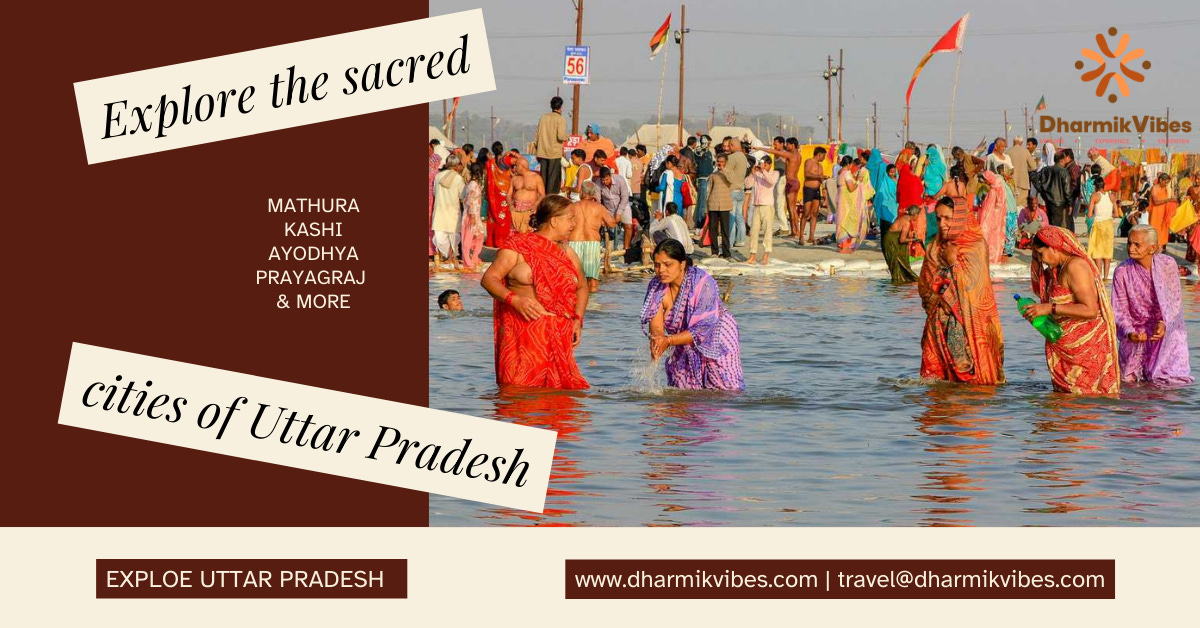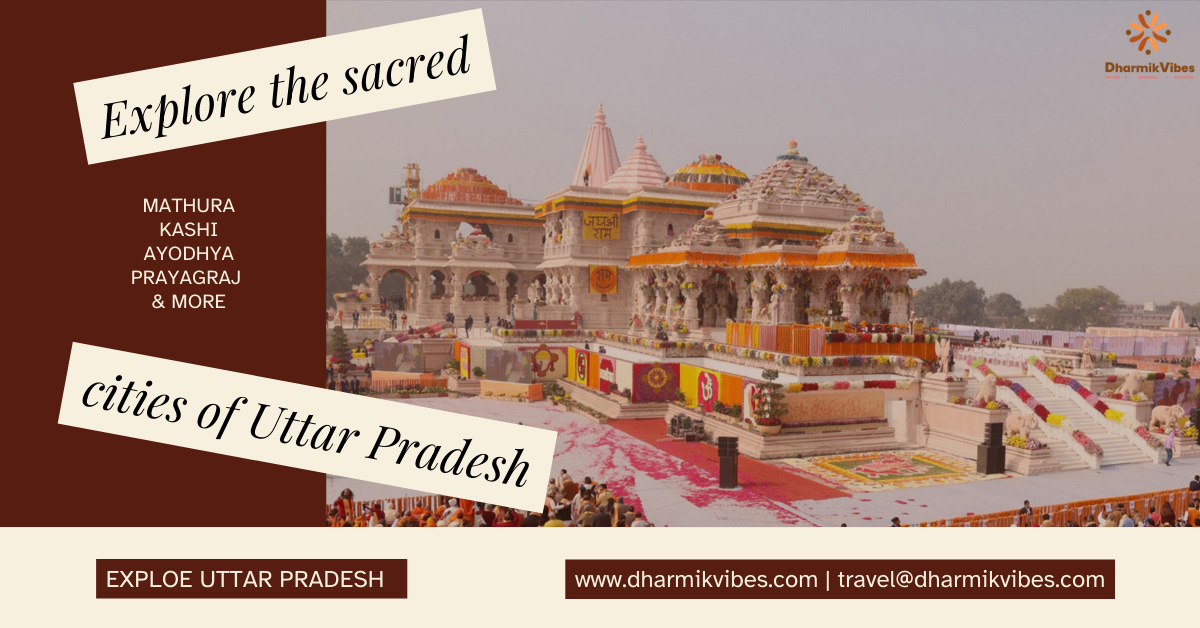Uttar Pradesh Religious Series Part 6: Interfaith Dialogues, Social Change, and Future Prospects in Uttar Pradesh’s Spiritual Heritage
Uttar Pradesh has long been a melting pot of religious traditions and cultural narratives. In this final segment, we examine how the state’s rich heritage has fostered interfaith understanding, contributed to social transformation, and continues to navigate the challenges of modernity while upholding time‑honored traditions.
1. Interfaith Dialogues: Building Bridges Through Shared Spirituality
a. Historical Context of Religious Coexistence
Uttar Pradesh’s history is marked by the convergence of diverse religious communities—Hindus, Muslims, Buddhists, and others have coexisted and interacted over centuries. This coexistence has enriched the region with a layered cultural narrative that emphasizes mutual respect and shared values. Historic sites such as Varanasi and Prayagraj have witnessed centuries of inter-religious exchange, where festivals, rituals, and daily practices reflect an inherent pluralism.
b. Contemporary Interfaith Initiatives
Case Study – The Harmony Project in Varanasi:
In recent years, local organizations in Varanasi have initiated the “Harmony Project,” a series of interfaith workshops, cultural festivals, and dialogue sessions that bring together spiritual leaders and community members from various religious backgrounds. The project aims to:
Promote mutual understanding and respect through shared religious practices.
Organize joint events during major festivals like Diwali, Eid, and Buddha Purnima.
Facilitate community service projects that address common social challenges such as poverty and environmental degradation.
Interviews and Testimonials:
Imam Saifuddin, a local Muslim leader, shared:
“In our city, the spiritual chants from temples and the soulful recitations from mosques are not isolated sounds. They have, over time, intertwined to create a symphony of devotion that speaks to the universal yearning for peace and understanding.”
Sadhvi Meera, a prominent Hindu spiritual guide, added:
“Our traditions teach us that the divine is present in every human being. By engaging in interfaith dialogue, we not only honor our own practices but also recognize the shared spirituality that binds us all.”
c. The Role of Art and Culture in Bridging Divides
Folk Performances and Joint Celebrations:
Cultural events in Uttar Pradesh increasingly feature collaborations that cross religious boundaries. Joint performances of Ramlila and Sufi music concerts are emerging as powerful mediums for conveying messages of unity and compassion.
Ramlila Fusion Events: Innovative groups are blending traditional Ramlila narratives with elements of Qawwali and Sufi poetry, symbolizing a fusion of cultural expressions that celebrate life’s transcendental beauty.
Visual Arts Collaborations: Artists from diverse backgrounds are organizing exhibitions that juxtapose classical temple art with modern interpretations of spiritual themes. These exhibitions provide visual testimonies of interfaith respect and a shared commitment to preserving heritage.
2. Religious Heritage as a Catalyst for Social Change
a. Empowering Local Communities Through Spiritual Initiatives
Community Development Projects:
Across Uttar Pradesh, temples and religious institutions have taken on roles beyond the purely devotional sphere. They are increasingly becoming centers for social welfare, education, and healthcare.
Educational Outreach: Many temple complexes host schools and vocational training centers. For instance, a centuries‑old temple in a small town in Siddharthnagar now runs a free school that educates underprivileged children in both secular subjects and traditional values.
Healthcare Services: In cities like Gorakhpur and Bareilly, temple trusts collaborate with local governments to offer free medical camps and wellness programs, thereby ensuring that the divine mission of service extends to tangible social support.
Success Stories:
A notable example is the “Jyoti Project” in Prayagraj, initiated by a group of temple priests and local entrepreneurs. This project focuses on:
Skill Development: Offering training in traditional crafts, modern technology, and sustainable agriculture.
Women's Empowerment: Establishing self-help groups among women, which not only preserves indigenous arts and crafts but also enhances economic independence.
Environmental Stewardship: Promoting eco-friendly practices in temple premises and surrounding communities, including waste management and reforestation efforts.
b. Religious Institutions and Social Justice
Advocacy and Community Mobilization:
Religious institutions in Uttar Pradesh have historically played a crucial role in advocating for social justice. In modern times, these institutions are mobilizing communities to address challenges such as gender inequality, caste discrimination, and economic disparity.
Inclusive Worship Practices: Some temples and ashrams are revising their practices to be more inclusive, welcoming individuals from all social and economic backgrounds. This shift is particularly evident in urban centers like Varanasi and Lucknow, where progressive leaders are championing reforms that reflect contemporary values while staying true to ancient teachings.
Public Dialogues: Intergenerational dialogues organized by religious institutions are opening spaces for discussions on social reform, human rights, and environmental protection. These dialogues encourage community members to think critically about the ways in which ancient traditions can be harnessed to solve modern problems.
3. Modern Challenges and Strategies for Preservation
a. Urbanization and Environmental Degradation
Balancing Development with Heritage Preservation:
Rapid urbanization poses a significant threat to Uttar Pradesh’s sacred sites. Historic temples and ghats face challenges from encroachment, pollution, and infrastructural neglect.
Government Initiatives: Efforts are underway at both the state and national levels to protect heritage sites. Policies aimed at reducing industrial pollution in the Ganges, restoring ancient structures, and enforcing regulations against encroachment are critical to preserving the sanctity of these spaces.
Community-Led Conservation: Local communities are taking initiative through projects like “Green Ghats,” where residents organize clean-up drives, tree-planting campaigns, and educational workshops on the ecological significance of sacred rivers and groves.
b. The Commodification of Spirituality
Navigating the Tension Between Devotion and Commercial Interests:
With the increasing popularity of pilgrimage tourism, there is a delicate balance to be maintained between genuine spiritual experiences and commercial exploitation.
Ethical Tourism Guidelines: Various non-profit organizations and government agencies are working to establish guidelines that ensure pilgrimage sites remain places of worship rather than mere tourist attractions.
Sustainable Business Models: Initiatives promoting community-run homestays, artisanal markets, and cultural tours are designed to generate income without compromising the integrity of sacred practices. By prioritizing local participation and fair trade practices, these models seek to create a symbiotic relationship between economic development and spiritual preservation.
c. The Digital Divide and Access to Tradition
Ensuring Inclusive Access in a Digital Age:
While digital platforms have revolutionized the way spiritual content is shared, there is a risk that the digital divide could leave behind those in remote areas.
Bridging the Gap: Efforts to expand internet connectivity in rural Uttar Pradesh, along with initiatives that provide training in digital literacy, are crucial. Mobile libraries, community internet centers, and government-supported digital outreach programs aim to make the benefits of technology accessible to all.
Culturally Sensitive Content: Digital archives, online classes, and virtual tours must be developed in multiple local languages and dialects to ensure that the richness of Uttar Pradesh’s spiritual heritage is communicated effectively to diverse audiences.
4. Future Prospects: Research, Collaboration, and Innovation
a. Expanding Academic and Cultural Research
Interdisciplinary Studies:
The multifaceted nature of Uttar Pradesh’s spiritual landscape invites collaboration among historians, archaeologists, sociologists, environmentalists, and technologists.
Research Centers and Think Tanks: Universities and cultural institutions in Uttar Pradesh are increasingly establishing dedicated research centers that focus on heritage studies. These centers are producing scholarly work on ancient texts, temple architecture, and the socio-economic impact of religious festivals.
Collaborative Projects: Cross‑regional and international collaborations are helping to bring global attention to the state’s spiritual heritage. Joint projects that involve digitization, archaeological excavations, and environmental conservation not only contribute to academic knowledge but also provide practical frameworks for heritage preservation.
b. Fostering Global Cultural Exchanges
International Conferences and Workshops:
By hosting global cultural festivals and academic conferences, Uttar Pradesh is positioning itself as a hub for discussions on spirituality, sustainability, and cultural preservation.
Global Pilgrimage Forums: Events that bring together spiritual leaders, scholars, and policymakers from around the world can facilitate the exchange of ideas and best practices. These forums serve as incubators for innovative approaches to integrating ancient traditions with contemporary challenges.
Cultural Residencies and Exchange Programs: Initiatives that invite international artists and researchers to reside in Uttar Pradesh for extended periods are fostering a vibrant exchange of cultural insights. These residencies often culminate in exhibitions, public lectures, and collaborative performances that celebrate the universal appeal of Uttar Pradesh’s spiritual heritage.
c. Innovating for the Future
Technology and Tradition:
The future of Uttar Pradesh’s religious heritage lies in the innovative fusion of technology and tradition.
Virtual Reality (VR) Pilgrimages: Emerging technologies such as VR and augmented reality (AR) offer the potential to create immersive digital experiences that replicate the ambiance of ancient temples and sacred ghats. Such initiatives can democratize access to spiritual experiences, allowing individuals worldwide to explore Uttar Pradesh’s heritage virtually.
Mobile Apps and Interactive Platforms: Custom-designed mobile applications that provide real‑time updates on rituals, festivals, and temple events are becoming increasingly popular. Interactive platforms that enable users to explore digital archives, participate in live-streamed events, and engage with spiritual mentors online are reshaping the future of religious engagement.
Blockchain for Heritage Conservation: Innovative projects are exploring the use of blockchain technology to document and verify the authenticity of ancient artifacts, temple records, and oral histories. This decentralized approach can provide a secure and transparent means of preserving and sharing Uttar Pradesh’s cultural legacy.
5. Concluding Reflections: A Vision for Tomorrow
Uttar Pradesh’s spiritual heritage is not a static relic of the past; it is a vibrant, evolving narrative that continues to inspire transformation and unity. In the face of modern challenges, the enduring values of devotion, inclusivity, and cultural pride offer a guiding light for the future.
a. A Call to Action
The journey we have traced through the sacred sites, festivals, rituals, and artistic expressions of Uttar Pradesh serves as a powerful reminder of our collective responsibility:
For Policymakers and Cultural Leaders: It is imperative to craft policies that protect and promote heritage sites while ensuring sustainable development.
For Communities and Devotees: Embracing both tradition and innovation will empower local voices, ensuring that ancient wisdom is passed on to future generations.
For Global Citizens: By engaging with Uttar Pradesh’s spiritual heritage—whether through pilgrimage, study, or digital exploration—we all become part of a global movement to preserve a legacy that transcends borders and time.
b. A Vision for a Harmonious Future
In a rapidly changing world, the spiritual legacy of Uttar Pradesh stands as a beacon of resilience, compassion, and unity. By fostering interfaith dialogue, championing sustainable practices, and embracing modern tools to share ancient wisdom, we can forge a future where tradition and innovation coexist harmoniously.
As we conclude this six‑part series, let us remember that the true strength of Uttar Pradesh’s heritage lies not just in its monuments or festivals, but in the hearts of its people—the artisans, priests, scholars, and everyday devotees who continue to live their faith with passion and integrity.
May the insights shared throughout this series inspire you to explore, engage, and contribute to the preservation of this sacred legacy. Together, we can ensure that the divine tapestry of Uttar Pradesh not only survives but thrives, lighting the way for generations to come.
From the ancient ghats of Varanasi and the storied temples of Mathura to the intimate village shrines and digital prayer circles of today, Uttar Pradesh’s spiritual heritage remains a dynamic force—a living legacy that bridges the past and the future. As we close this series, we invite you to reflect on the myriad ways in which faith, art, and community intertwine to shape a region that continues to inspire awe and devotion across the globe.
Jai Shri Ram, Jai Shri Krishna, and may the eternal light of Uttar Pradesh guide you on your journey of discovery and transformation.
Uttar Pradesh Series: A Spiritual Tapestry of Tirth, Temples, & Timeless Traditions: A Comprehensive Religious Map
Uttar Pradesh Religious Map & its history is divided in to 6 Parts.



